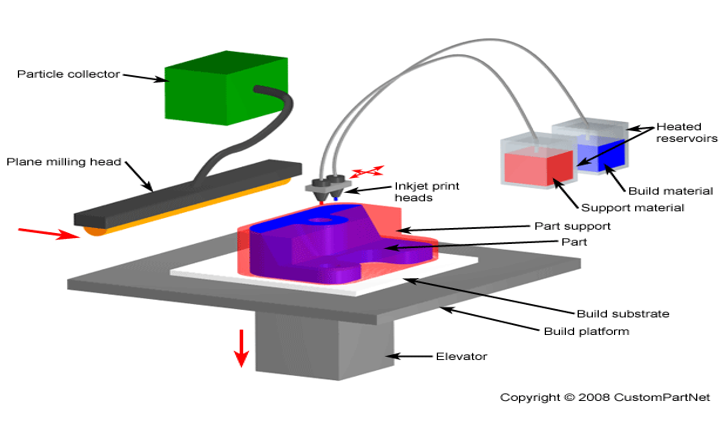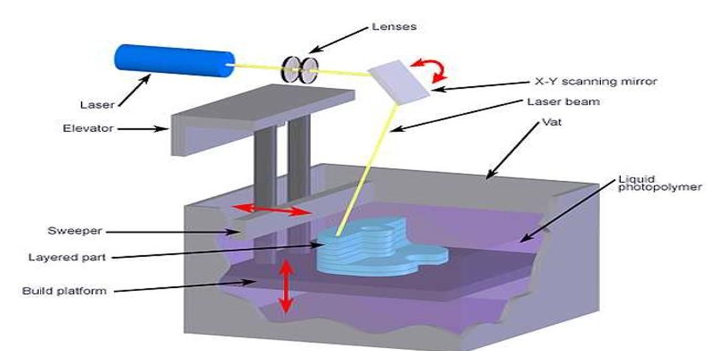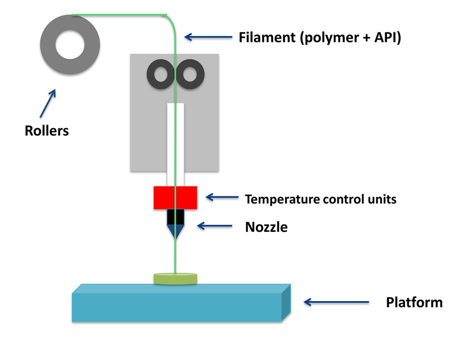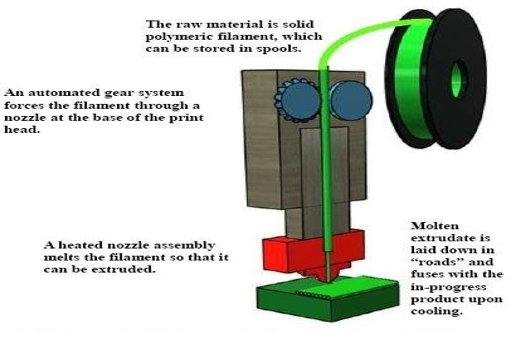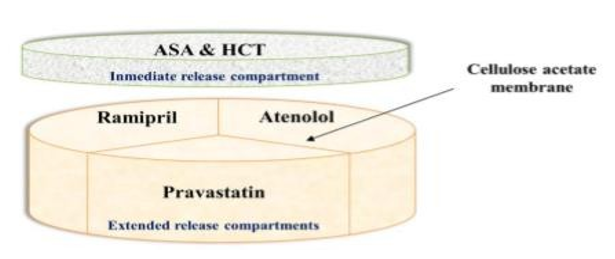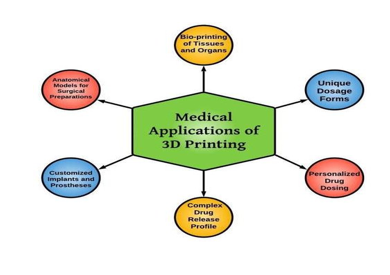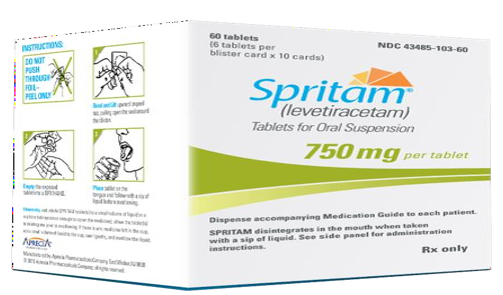Introduction
3D Printing
A new method of fast prototyping, three-dimensional printing, involves depositing successive layers of material to create solid things.1 Three-dimensional printing creates items by layering various materials such as plastic, metal, ceramics, powders, liquids, or even live cells, and then melting or depositing them. The many potential uses of 3D printing technology in the healthcare sector have piqued the interest of the pharmaceutical and medical device industries. While this technology has been around for a while, it has recently gained a lot of attention owing to the approval of 3D-printed tablets and other medical devices. Additionally, the US Food and Drug Administration has issued guidelines regarding technical considerations that are unique to devices that use additive manufacturing, which includes 3D printing. All of this has sparked a lot of thought about this technology, which is necessary for successful delivery of the intended product.2
Three-dimensional printing (3DP) has several uses in the medical industry, including medication and delivery system design, tissue engineering, organ printing, diagnostics, and the production of biomedical equipment. Imaging modalities such as computed tomography (CT) scans and magnetic resonance imaging (MRI) can generate data to create complex anatomical and medicinal structures tailored to each individual patient's needs. We also use this technique to replace and repair kidneys, hearts, and other organs, and to create new organs that function similarly to the originals.3
These days, 3D printing continues to expand its uses while being one of the most rapidly evolving areas of technology, art, and science. "Fabrication of objects through the deposition of a material using a print head, nozzle, or another printer technology" is how the International Standard Organisation (ISO) described three-dimensional printing. Unlike the more popular formative and subtractive production methods, This approach is a kind of additive manufacturing (AM) that involves layer-by-layer material joining to create components from 3D model data. Among the many benefits of the so-called rapid prototyping (RP) method are the following: a decrease in the time and money needed for prototyping; the ability to make changes to a product at the design level; the prospect of producing tiny items; and the creation of unique product lines or structures that would be impossible to create using subtractive methods.4 Microcapsules, complex drug-release profiles, suspensions, and multilayered drug delivery devices are only a few examples of the innovative dosage forms created by 3D printing in the pharmaceutical industry. 3D printing as a tool for "adjuvant manufacturing" in the pharmaceutical industry is just another example of additive manufacturing (AM). Using a sequential stacking process, 3D printing allows for the automatic creation of solid objects of almost any form from digital models. This means that the technique is based on the same basic principle: to build a 3D envelope by adding material layers sequentially. This word often refers to a wide variety of AM (additive manufacturing) processes.5
Therefore, it is also known as “additive manufacturing," “rapid prototyping,” “layered manufacturing," "computer-assisted manufacturing,” and “solid free-form fabrication.”.
It also offers important advantages from an industrial point of view, such as cost-effectiveness, increased productivity, democratisation of design and manufacturing, and enhanced collaboration. The use of 3DP methods in the pharmaceutical manufacturing of drug products has grown in popularity recently. These methods have many benefits over traditional ones, such as the ability to make complex solid dosage forms with high accuracy and precision, the ability to customise and personalise medicines with individually adjusted doses, on-demand manufacturing, and lower costs. All 3DP technologies are based on the principle of building 20 objects by adding materials layer by layer. For example, in 2015, the U.S. Food and Drug Administration approved 10 Spritam® by Aprecia Pharmaceuticals, the first drug manufactured using 3D printing technology (3DP)6 3D printing can play a significant role in multiple active ingredient dosage forms, where the formulation can be a single blend or multi-layer printed tablets with sustained release properties. This reduces the frequency and number of dosage units consumed by the patient in their daily routine. The polypill concept, an individualised dosage form concept, holds significant potential for 3D printing technology. This brings about the possibility of combining all the drugs required for the therapy into a single dosage form. Three-dimensional printing technology, a novel rapid prototyping technique, constructs solid objects by sequentially depositing several layers. Rapid prototyping involves the construction of physical models using computer-aided design in three dimensions. It is also known as additive manufacturing and solid-free-form fabrication. Personalized and programmable medicine can utilise the unprecedented flexibility that 3D printing technology has enabled in the design and manufacturing of complex objects.7
History of 3d Drug Printing
People saw 3D printing as a potential platform for customised healthcare in the 1990s. The FDA's Centre for Device and Radiological Health (CDRH) has examined and approved 3DP medical devices, which is a huge step forward in the field of 3D-printed medical equipment.8 The first 3D printing technology in pharmaceuticals was inkjet printing a binder solution onto a powder bed, binding the particles together. We carried out iterations of this technique until we achieved the final, intended structure. Sachs et al., at the Massachusetts Institute of Technology, patented this technology in the early 1990s. Compared to the pharmaceutical business, which is still in its early stages of 3D printing, the automotive, aerospace, biomedical, and tissue engineering sectors are well ahead of the curve. Using risk-based methods, the FDA promotes the development of innovative manufacturing technologies, such as 3D printing.9
Table 1
The evolution of 3d printing technology
Advantages of A 3D Printed Drug Delivery Over Other Methods
It is feasible to manufacture small batches and complete the process in a single run. The process exhibits a high drug loading ability when compared to conventional dosage forms.
The process guarantees accurate and precise dosing of potent drugs in small doses. This process also lowers production costs by minimizing material waste.
Suitable drug delivery for difficult-to-formulate active ingredients, such as those with poor water solubility and drugs with a narrow therapeutic window
Genetic variations, ethnic differences, age, gender, and environment can all influence how a patient receives their medication.
Customizing the treatment for multi-drug therapy with a multiple-dosing regimen can enhance patient adherence.
3DP allows for controlled droplet size, complex drug release profiles, and strength.
3D printers occupy minimal space and are Objects produced by 3D printing are low-cost. Because almost all ingredients are inexpensive, it is an advantage for small-scale production units or companies that produce highly complex products or parts.
Used to produce 3D-printed medical devices
Most Commonly Used Techniques in 3d Printing
3D printing encompasses a wide range of manufacturing processes, all of which rely on the controlled digital deposition of materials in layers to produce freeform shapes. The majority of additive manufacturing techniques used in 3D printed pharmaceuticals are as follows: The methods and materials used for layer deposition are the key differentiators.
Inkjet printing
This approach to personalized medicine is based on the same technique as computer-operated inkjet printing (Figure1). Pharmaceutical applications adapted it by substituting the ink with drug-containing pharmaceutical solutions and edible sheets known as substrates for normal paper. This technique deposits the ink onto a substrate either through continuous inkjet printing (CIJ) or drop-on-demand (DoD) printing, thereby offering a high-resolution printing capability (Table 2). Known as a'mask-less' or 'tool-less' approach, inkjet printing relies primarily on the movement of the inkjet nozzle or the substrate to form the desired structure accurately and reproducibly. It has a low processing cost, rapid processing rates, minimal waste generation, gives CAD information in a ‘direct write’ manner, and processes material over large areas with minimal contamination. 10
Advantages
In a home office or small business, an inkjet printer's portability and minimal footprint make it an attractive option. Inkjet printers typically weigh around 20 pounds and include ink cartridges that snap into position for simple replacement.
Stereolithography
Curing photosensitive material(s) (photopolymerization) to create a three-dimensional object (Figure 2). SLA works by slowly moving a focused UV laser over a liquid that can be photopolymerizable. It then uses a digital mirroring system to start a chemical reaction inside the photopolymer, which makes the exposed area harden. We construct each component of the entity by iteratively repeating this method. 11
Advantages Stereo lithography's speed is one of its advantages; it allows for the production of functioning pieces within a day. A single part's production time can range from a few hours to over a day, depending on the project's size and complexity.
Disadvantages- It has often been expensive Technology.
Fused deposition modelling (FDM)
Fused deposition modelling (FDM), a popular 3D printing method, involves heating the materials to a point where they melt, enabling printing. This is why Table 3 provides information on various types of dosages. Fused deposition modeling (FDM) 3D printing enables the creation of individualized dosage medications and delayed release printlets that do not have an outside enteric coating.The first step in successfully printing oral dosage forms is to extrude the FDM feedstock filament, which contains the drug(s), polymer(s), and any additives. Depending on the technique, the feedstock's thermal, rheological, and mechanical qualities must be considered. Dosage form weight, porosity/surface area, dissolving characteristics, mechanical properties, and drug distribution are all important for the final product characterization.
Using a high-temperature nozzle, a thermoplastic filament is extruded layer by layer, forming a filament in a semi-solid fused state. 12
Advantages
Layer by layer, a high-temperature nozzle extrudes a thermoplastic filament into a semi-solid fused state. 12
Nozzle-Based Deposition Systems
Nozzle-based deposition (Fig. 4) systems consist of the mixing of drugs, polymers, and other solid elements prior to 3D printing. A nozzle passes through the mixture, generating the three-dimensional product layer by layer. Depending on the material type, there are two types of printing: fused deposition modelling, which uses melted components, and ressure-assisted microsyringes, which do not require the use of melted materials. We use this technique prior to 3D printing. 13
Polypill concept
A "polypill" (fig. 5) is a single tablet that contains a mixture of many medications. This idea is especially useful for the elderly, since they often have to take many medications for different conditions. Using 3D extrusion-based printing, the 'polypill' demonstrates the ability to combine multiple medications into a single tablet, allowing for customization to meet individual needs. Captopril, nifedipine, and glipizide are the active ingredients in the tablets that demonstrate this idea. The pills also include an osmotic pump. This medication combination could potentially manage hypertension in diabetics. We printed the formulations using an extrusion method that operates at room temperature. The excipient the pharmaceutical sector frequently uses the excipients used in this procedure. 14 which loads many APIs into a single tablet, allows for the consolidation of complicated prescription regimens into one. Recently, manufacturers have manufactured polypills with controlled release profiles using 3DP technology.
Material Used in 3d Printing Technology
Since 3D printing's infancy, the materials available for the technique have advanced significantly. We have used this plastic for 3D printing because it is robust, flexible, and long-lasting. 7 You can tint it either before or after printing, despite its default white hue. You can make Alumide, a popular 3D printing material, by mixing this substance (in powder form) with powdered aluminium. A. B. S., or acrylonitrile butadiene styrene, is another popular filament material for entry-level F.D.M. 3D printers, as well as other common 3D printing plastics. Entry-level FDM 3D printers often use filament variants of this common plastic. This plastic is available in a rainbow of hues and is quite durable. Among the many reasons for ABS's widespread acclaim is the abundance of non-proprietary filament suppliers. This is precisely why P. L. A., or poly lactic acid, has become so popular in the 3D printing community; it is a biodegradable plastic. Titanium has been used in industrial 3D printing because it is one of the strongest metals conceivable. 15 A vast array of materials are now available in a number of various forms, including powder, filament, pellets, granules, resin, and many more. These days, it's common practice to tailor material development to specific platforms and applications; for instance, the dentistry industry utilizes materials with highly tailored qualities for its work. The sintering technique and nylon or polyamide filaments are two of the most prevalent forms of this plastic. Since 3D printing's infancy, the materials available for the technique have advanced significantly. Nowadays, you may get a broad range of materials in a number of various forms, including powder, filament, pellets, granules, resin, and many more. The year 19 Materials for 3D printing: Metals and metal composites are increasingly being used in industrial 3D printing. Derivatives of cobalt and aluminium are two of the most popular. Because of its strength, stainless steel powder is one of the most popular and widely used metals for 3D printing in the sintering, melting, and E.B.M. (electric beam additive manufacturing) processes. 16
Medical Applications of 3d Drug Printing
The rapid growth of 3D printing's pharmaceutical applications is causing a sea change in the medical industry. The pharmaceutical industry is already making use of 3D printing technology for both research and production. The capacity to create dosage forms with complicated drug-release profiles, excellent repeatability, and exact control over droplet size and dosage are all benefits of 3D printing. 3D printing technology now simplifies, standardizes, and enhances the feasibility of complex medication production procedures. 3D printing technology may also benefit the advancement of personalized medicine. The use of 3D printing technology has made it possible to personalise medicine dose forms, release profiles, and dispensing for every patient. We can use 3D printing to create pharmaceuticals through the process of "precision drug dispensing". It is possible to personalise the medications so that they fit the particular requirements of those who use them. Here are some potential benefits of implementing 3D printing technology in the pharmaceutical industry:
Personalized Medicine
The purpose of drug development should be to increase efficacy and decrease the risk of adverse reactions, a goal that can potentially be achieved through the application of 3D printing to produce personalized medications. Oral tablets are the most popular drug dosage form because of ease of manufacture, pain avoidance, accurate dosing, and good patient compliance. However, no viable method is available that could routinely be used to make personalized solid dosage forms, such as tablets. Oral tablets are currently prepared via well-established processes such as mixing, milling, and dry and wet granulation of powdered ingredients that are formed into tablets through compression or molds. Each of these manufacturing steps can introduce difficulties, such as drug degradation and form change, possibly leading to problems with formulation or batch failures. A pharmacist could then print and dispense the personalized medication via an automated 3D printing system. If necessary, the dose could be adjusted further based on clinical response. 3D printing also has the potential to produce personalized medicines in entirely new formulations, such as pills that include multiple active ingredients, either as a single blend or as complex multilayer or multi reservoir printed tablets. Providing patients with an accurate, personalized dose of multiple medications in a single tablet could potentially improve patientcompliance.Increasingtheefficacyofdrugsandatthesametimereducingthechancesof
adverse reaction should be the aim of drug development, which can be achieved by using 3D printing to fabricate personalized medications. 17
Or dispersible high-dose medications
3D printing technology helps to produce Or dispersible high-dose medications (up to 1000 mg) without using compression forces or traditional molding techniques. 3D printer stitches together multiple layers of powdered medication using an aqueous fluid to produce a porous, water-soluble matrix that rapidly disintegrates with a sip of liquid (ZipDose Technology).
Another strategy that can be adopted to improve adherence to therapeutics is the design of delivery systems able to overcome the limitation of conventional oral liquid and solid dosage forms. Liquids (i.e., syrups, suspensions and solutions) are very flexible in dosing and can be easily swallowed by the patient. However, the dose accuracy is strongly affected by the type of measuring device used by the patient (e.g., spoon, syringe) and the risk of misdosing is high due to incorrect handling. Therefore, tablets and capsules are the most commonly used dosage forms. However, they are more difficult to swallow by children and older adults, especially when their shape and size have not been properly optimized. To solve these criticisms and improve patients’ adherence, or dispersible dosage forms (ODx) can be a valid technological solution. 17
Complex drug release profile
Most traditional compressed dosage forms often exhibit a homogeneous combination of active substances and a straightforward drug release profile. Three-dimensional (3D) printed dosage forms, on the other hand, have a complex drug release profile that lets complex geometries be made that are both porous and filled with multiple medications, with barrier layers that control release. As an example, consider a multi-layered bone implant that uses a pulse release mechanism to alternate between rifampicin and isoniazid, producing a different drug release profile. 18
Bioprinting of tissues and Organs
Organ transplantation from a donor is the current solution to the problem of organ and tissue failure due to accidents, congenital flaws, aging, and so on. This is a serious medical issue. Donors, whether alive or not. Unfortunately, there is a severe lack of organ donors, so only a small number of patients ever get the life-saving transplants they need. Organ transplant operations are also prohibitively costly, putting them out of reach for most individuals. The difficulty in locating donors with a suitable tissue match is another concern plaguing transplant procedures. The standard approach to tissue engineering involves taking a small tissue sample, isolating stem cells, mixing them with growth factor, and then growing them in a lab. The final step entails seeding the cells onto scaffolds that guide cell growth and differentiation into mature tissue. We construct the scaffolds using a variety of materials, selecting specific materials based on the tissue type, desired strength, and porosity. When it comes to constructing soft tissues, hydrogels are supposedly the best option. 18
Customized implants and prostheses
In as little as 24 hours, you may have a prosthetic limb or surgical implant, no matter how simple or complicated the design. Despite their widespread manufacturing, the certification procedure for spinal, dental, and hip implants remains lengthy. Surgeons used to have to make metal and plastic parts, do bone grafting, or use drill machines to shape and size the implants to fit properly. 3D printing has also found commercial success with Invisalign braces. Hence, the additive manufacturing approach provides a cost decrease for customising prostheses. 19
Anatomical models for surgical preparations
The use of 3D-printed models in surgery has grown significantly. Neurosurgeons profit substantially from 3D-printed neuro-anatomical models due to the complexity of the human brain. It may be difficult to get full information on the interconnections of the skull, brain, cranial nerves, and arteries from radiography and 2D photographs alone due to the potentially fatal effects of even a little error in medical treatments. 3D printing has several possible medical applications, including the development of custom surgical instruments, guides, and implants. Therefore, the additive manufacturing method allows for the customization and affordability of surgical equipment. 19
Table 2
Various techniques are used for formulation of pharmaceutical formulations
Challenges in 3d Printing Technology
The pharmaceutical industry has found 3D printing to be a promising technique, opening the door to patient-centred, tailored treatment. Since rapid prototyping (RP) may be done in minutes, it provides many benefits, including boosting production speed and cost efficiency. Guaranteeing that 3D-printed medications are as safe, effective, and stable as pharmaceuticals traditionally made by the pharmaceutical industry remains a substantial obstacle. 20 The regulatory authorities have significant challenges in establishing rules, legislation, quality systems, and ensuring the safety of 3D-printed pharmaceuticals. This is due to the pharmaceutical industry's traditional needs. Ethical concerns, compliance with FDA safety regulations, the creation of illegal weapons and pharmaceuticals, and the violation of intellectual property laws are among the topics that have sparked debates around 3D printing. 21 When it comes to creating personalised dosage forms, 3D printing has a few obstacles that need to be addressed before it can be extensively employed.
Process challenges
When choosing raw materials, it is important to consider their printability, physicochemical properties, thermal conductivity, print fluid characteristics, and viscoelasticity, in addition to their safety for human use.
Nozzle mechanism
During the 3D printing process, a nozzle mechanism creates the dosage form's layers. During the process of sequential layer generation, the printer head pauses and resumes.There must be an ongoing supply of printing material. At this level, clogged nozzles in the printer head, scraping, binder migration, bleeding, and incorrect powder feeding are common issues. 22
Powder based 3D printing
Powder leakage is a serious problem that might hurt employees; hence, the printing process has to be done in a controlled environment. 23
Surface imperfections in finished product
Plastic beads or large-sized powder are stacked on top of one another. Since the Surface imperfections become more likely when powder-based and extrusion-based dosage forms require longer drying times. nd method of drying can also affect surface imperfections. 24
Future Prospects
Potentially revolutionary new avenues for biotechnology and pharmaceutical research may emerge as a result of recent developments in 3D printing. 3D printing has a lot of potential future applications in the pharmaceutical industry, including the following: the creation of new dosage forms, the optimisation of drug release profiles, the creation of excipients, the prevention of drug incompatibilities, the enhancement of delivery systems, the limitation of biological molecule degradation, and the advancement of cure research. When it comes to individualized healthcare, 3D printing has the potential to open up whole new avenues of exploration. The basic gist of what the researchers and specialists are proposing is to make individual 3D-printed pills to take orally. For prescriptions with a short shelf life or those tailored to individual patients, on-demand printing of pharmaceuticals could serve as an alternative to conventional compounding pharmacies. This may pave the way for breakthroughs in garage biology down the road. 3D printing raises worries about safety and security due to the lack of regulation around the technology, which is still in its early stages. We will resolve these issues in the near future. The use of 3D printing technology to create medications is the wave of the future. Healthcare and medicine have not yet fully utilized 3D printing's potential for direct-write pharmaceutical production, despite the widespread adoption of the technology by several businesses throughout society. We anticipate that this specific use of 3D printing will transform pharmacies, and that personalized medicine will reach new heights of potential as a result of ongoing research. 25
Spritam Recent advances in 3D printing have the potential to open up potentially game-changing new pathways for research in pharmaceuticals and biotechnology. New dosage forms, optimized drug release profiles, excipients, delivery systems, limits on biological molecule degradation, advancements in cure research, optimization of drug incompatibilities, and excipients are just a few of the many possible future uses for 3D printing in the pharmaceutical industry. 3D printing may open up new possibilities in the field of personalized healthcare. Experts and researchers propose the creation of individual 3D-printed tablets for oral consumption. Instead of using traditional compounding pharmacies, on-demand printing of medications might be a viable option for patients with short-term or individualized prescription needs. This could lead to future advances in garage biology. There is a lack of regulation around 3D printing, which is causing concerns about safety and security. The technology is still in its early phases. Within the next several days, we will fix these problems. The use of 3D printing technologies represents the future of medicine. Despite the widespread acceptance of 3D printing by numerous enterprises across society, healthcare and medicine have yet to properly use the technology for direct-write pharmaceutical manufacture. We expect this particular use of 3D printing to revolutionize pharmacies, and further research will propel personalized medicine to unprecedented heights of promise. 25
Conclusion
3D printing technology has the potential to significantly impact the growing field of personalised medicine by tailor-making nutritional supplements, organs, and medications. Projections indicate a growing use of this technology in pharmacy settings. One possible future where pharmaceutical corporation no longer manufacture and distribute pharmaceuticals is when pharmacies get databases of prescription formulas by email and may print them on demand. As a result, the current systems of medicine distribution and production would undergo a sea shift, becoming far more efficient and economical. If this option becomes available for the majority of drugs, patients may be able to take only one tablet per day, which would make it easier for them to take their prescription as prescribed. By making it possible to create a medicine specifically for each patient, these innovations will revolutionise the pharmaceutical industry. By making it possible to create a medicine specifically for each patient, these innovations will revolutionise the pharmaceutical industry. As a result of 3D printing, personalised technology has emerged as a promising new tool for the pharmaceutical industry. Due to its inherent flexibility, 3D printing technology is rapidly emerging as a promising new frontier in the administration of modern drugs, particularly those that require customization for individual patients. The pharmaceutical industry's production methods and formulation strategies will undergo a sea change as a result of 3D printing technology. In this piece, we have laid out our case for why 3D printing is a beneficial choice for the pharmaceutical industry. We discussed three different 3D printing techniques as potential solutions for the pharmaceutical industry: selective laser sintering, inkjet printing, and extrusion-based printing. Possible materials for drug loading and printing include solid filament materials and hydrogels, both natural and manmade. We also advanced several arguments in favour of 3D printing pharmaceuticals, including the potential to control the release characteristics of the medications, print specific and individual dosages, and leverage the inherent on-demand capabilities of the printing method.

